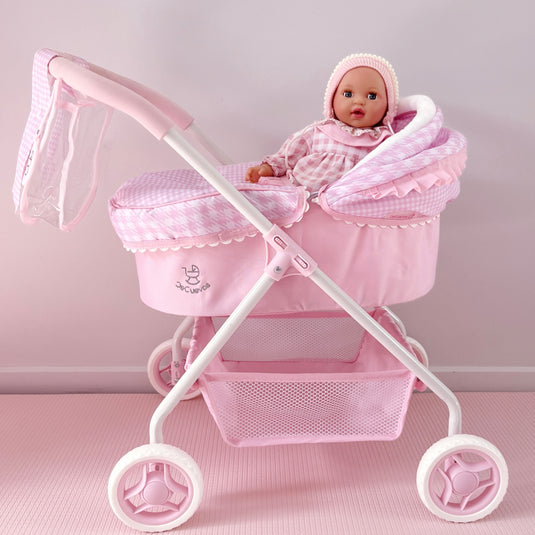Rumored Buzz on Dolls And Accessories
Table of ContentsDolls And Accessories Fundamentals ExplainedSome Known Factual Statements About Dolls And Accessories Some Known Details About Dolls And Accessories Our Dolls And Accessories StatementsHow Dolls And Accessories can Save You Time, Stress, and Money.Some Ideas on Dolls And Accessories You Should KnowAn Unbiased View of Dolls And Accessories
When dolls are consisted of in group play, youngsters exercise waiting, sharing, and listening to others' concepts. Whether they're claiming to be a parent, sibling, or buddy, children learn exactly how connections workhow to support others, address arguments, and care for somebody else. These very early role-play experiences come to be the foundation for healthy friendships and relationships later on in life.Duplicating calming routines with a doll (feeding, rocking, putting to bed) can help kids feel tranquil and safe and secure. These calming routines show them how to self-regulate. Caring for a doll can make a youngster feel capable and certain - european dolls. It offers them a sense of obligation and control in a world that commonly feels uncertain.
Dolls And Accessories - An Overview
When children see dolls that show their race, heritage, and society, it reinforces a favorable sense of identity. It claims, "You belong. Your tale issues." Dolls additionally introduce youngsters to cultures outside their very own, developing considerate curiosity and empathy for others. This is where comprehensive play can lead to inclusive neighborhoods.
As Dr. Karyn Purvis, a leader in youngster growth and trauma-informed treatment, once said: This powerful quote highlights how play isn't simply funit's exactly how kids learn ideal. The mind cables itself through repetition. However when a kid is involved, joyous, and psychologically linked to an activitylike doll playthe mind reinforces those links faster and more meaningfully.
The Main Principles Of Dolls And Accessories

Young boys need compassion, generosity, and creativity tooand doll play offers that. Dolls are often a youngster's first "pal," aiding them practice partnerships, build communication abilities, and feel comforted.
Dolls And Accessories Fundamentals Explained
Through play. With pride. Via dolls that matter. Thanks for joining us on this trip. Samantha Ong Samantha Ong is the founder of Joeydolls, a Canadian-based toy brand on a goal to commemorate Asian societies via happy, inclusive play. Inspired by her very own experiences expanding up without social depiction, Samantha develops dolls that assist youngsters feel pleased with who they are while sparking curiosity and compassion in others.
Playing with dolls urges children to talk even more about others' thoughts and feelings, a research has discovered. The research suggests that playing fictional games with dolls could aid kids develop social skills, concept of mind and empathy. The neuroscientist that led the job claimed that the instructional value of playing with Lego and building toys was widely accepted, but the benefits of playing with dolls Home Page often appeared to have actually been forgotten."When kids create fictional worlds and function have fun with dolls, they interact in the beginning aloud and after that internalise the message about others' ideas, emotions and sensations," claimed Dr Sarah Gerson, a neuroscientist at Cardiff University and the lead writer.
The Main Principles Of Dolls And Accessories
They were additionally more probable to deal with the dolls in the second individual, speaking with them directly, whereas the characters on the computer system display they tended to refer to in the third person. No distinction was observed in between young boys and girls."Inner state language can indicate that a child is thinking concerning various other people's thoughts and emotions while playing with dolls," said Gerson.
And that they see language use in this respect is excellent verification of the theory."Mardell added that the findings ought to apply to any kind of kind of role-play plaything, as opposed to being certain to Barbies. "I 'd take a more comprehensive sight of what a doll is," he claimed." [Maybe] any kind of item that the child can invest a feeling of other right into a stuffed pet, a stove glove that speaks with them, or perhaps an imaginary friend."Children normally begin to reveal indicators of inner state language around the age of 4.
The smart Trick of Dolls And Accessories That Nobody is Discussing
"It ends up being essential for making and sustaining friendships, and how they pick up from their teachers, and parents."The research additionally found that the kids had increased mind task in the posterior exceptional temporal sulcus (pSTS) region when they talked as though their dolls had ideas and sensations. The pSTS area is thought to be involved in the development of social and emotional processing abilities.
Childhood years is not a fixed life stage; indeed, the meaning, significance and understanding of childhood years are all subject to alteration. By the 19th century among one of the most profound changes was the value positioned on enabling kids to experience "the carefree joys" of childhood through play activities. Play was currently thought about to be a critical part of a great youth.
In order to completely understand the significance of play, one should also understand the relevance of the doll. Nonetheless, dolls are a lot even more than toys developed to entertain girls. During the nineteenth century appropriate playtime activities were picked to advertise intellectual, physical or emotional development. Dolls were particularly prominent since they were believed to foster and nurture womanly top qualities such as compassion, caring and compassion.
All about Dolls And Accessories

It is only through archaeological examinations that scientists can intend to discover and record the full range of play experiences. Chronicling these experiences, and particularly the role of dolls, is critical for providing a more full image of childhood during the 19th century. Alarcn, Sara E - dolls., "Kid's Play: The Role of Dolls in 19th Century Youth" (2007 )